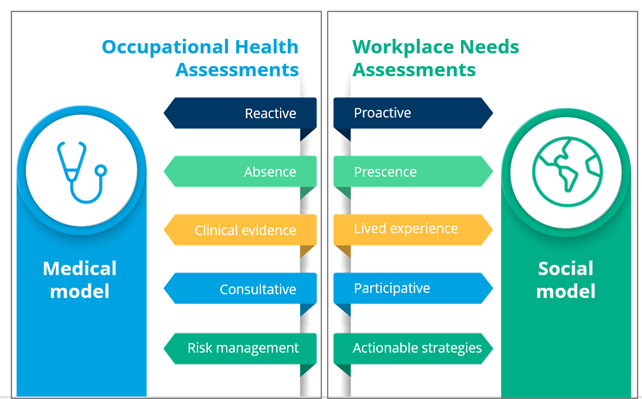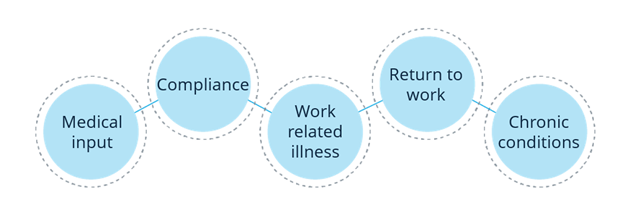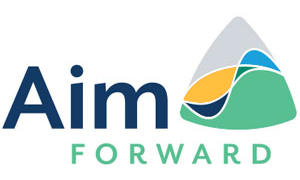The key differences between occupational health assessments and workplace needs assessments
Occupational health assessments and workplace needs assessments are very different, yet can work together in complementary ways. They both help support employee wellbeing and performance, and ensure legal compliance in the workplace. There are some key differences however and in this blog, we explore these differences, outlining when each assessment is helpful.
Medical vs social model

Occupational health: medical model
Occupational health is based on a medical model of disability. This means identifying and managing proven medical conditions impacting work. Adjustments focus on health management and safety.
Occupational health assessments are conducted by professionals who specialise in workplace health, such as occupational health nurses and physicians.
Workplace needs assessments: social model
Workplace needs assessments are based on a social model of disability. This means exploring the barriers that exist in the workplace and creating a more inclusive environment with the removal of these barriers.
At Aim Forward we also follow a celebratory model of disability, recognising the unique strengths that neurodivergent individuals and those with a disability bring to the workplace. We see diversity as a strength rather than something to be “fixed” or managed.
This makes the needs assessment process with Aim Forward a much more positive experience for employees and allows them to open up and share their experiences.
Workplace needs assessments are conducted by professionals who specialise in neurodivergence, mental health, and assistive technologies.
Key differences between occupational health and workplace needs assessments
Reactive vs Proactive
Occupational health assessments are often reactive, initiated to manage existing health issues or facilitate return-to-work procedures.
Workplace needs assessments proactively look at day-to-day strategies and removal of barriers to prevent issues before they impact productivity or well-being.
Absence vs Presence
Occupational Health assessments primarily support return-to-work strategies after an absence due to illness or injury, focusing on what the employee can or cannot do safely.
Workplace needs assessments are conducted in work, and support employees to thrive in their role. This includes exploring productivity gains, the removal of barriers in the workplace and employee wellbeing.
Clinical evidence vs Lived experience
Occupational health assessments rely on a medical diagnosis and clinical evidence to guide interventions, such as physical aids or therapeutic support.
Workplace needs assessments allow for self-diagnosis and are based on lived experience to understand the impact of neurodivergence or mental or physical health conditions in the workplace.
Consultative vs Participative
Occupational health assessments advise on changes required as a result of a medical diagnosis. These assessments may not consider support beyond the medical scope.
Workplace needs assessments follow a more inclusive, holistic and employee-led approach, actively listening to employees’ lived experiences to inform and integrate strategies.
Risk management vs. day-to-day strategies
Occupational health assessments are focused on managing risk and creating long-term health plans using medical, physical or therapeutic interventions.
Workplace needs assessments are focused on the day-to-day strategies employees can use in their roles. These include exploring productivity and well-being gains through assistive technology, AI & human interventions
When would an employee have an occupational health assessment?

1. If objective medical input is required
Occupational health assessments provide a thorough, objective and medically informed evaluation of an employee’s fitness for work, Assessments consider both physical and mental health. This ensures that employees can safely perform their roles without risk to themselves or others.
Unlike other assessments that may involve self-reporting or subjective data, occupational health assessments rely on clinical expertise.
2. If health & safety compliance is a concern
Occupational health assessments help employers comply with legal obligations under health and safety laws. This is especially crucial in industries where certain health standards must be met (e.g., construction and manufacturing) to protect both the employee and the organisation.
For roles that involve potential hazards (e.g. exposure to chemicals or heavy lifting), occupational health assessments ensure that risks are managed effectively by assessing whether an individual is physically capable of handling the job. This helps prevent workplace injuries.
3. If there is concern over the potential for work-related illnesses
Occupational health assessments can identify early signs of work-related health problems, such as musculoskeletal disorders or mental health stressors. By addressing these early, employers can reduce absenteeism, lower compensation claims, and improve workplace safety.
4. To support a return to work
Occupational health assessments support employees to return to work with appropriate adjustments after an illness or injury. This ensures a gradual reintegration without overburdening employees and reduces the risk of further absence.
5. To support the management of chronic conditions
Occupational health assessments can help employees with chronic health conditions manage their ability to continue working by recommending reasonable adjustments. These could include flexible working hours or ergonomic adjustments, ensuring long-term health support.
A workplace needs assessment can also explore the impact of t chronic conditions. Needs assessments can explore reasonable adjustments such as assistive technology, to support employees at work.. Employees with chronic conditions may consider accessing an occupational health assessment and a workplace needs assessment.
When would an employee have a workplace needs assessment?

1. To be proactive and put in place day-to-day strategies
Workplace needs assessments are inherently preventive, aiming to mitigate potential issues before they arise. It equips employees with tools and strategies that help them thrive in their role from the start, rather than waiting until problems develop.
Workplace needs assessments provide practical, day-to-day strategies that employees can use immediately.
2. To explore strategies that include assistive technology and AI
Workplace needs assessments can explore reasonable adjustments in the form of assistive technology, including
- such as speech-to-text software
- test to speech software
- mind mapping software
- wellbeing apps
- notetaking and task management apps
- AI tools like spelling and grammar checkers
These tools can help streamline work processes and help employees manage workloads to suit their cognitive preferences.
3. To explore the impact of a neurodivergence in the workplace
Workplace needs assessments are particularly beneficial for neurodivergent employees, including those with dyslexia, ADHD, autism, dyspraxia or dyscalculia. Neurodivergent employees may face barriers in the workplace due to their specific cognitive and sensory needs, These barriers require a broader holistic exploration by a professional with expertise in neurodivergence. This can help employees to thrive in their roles.
4. To explore the impact of menopause in the workplace
Workplace needs assessments are particularly beneficial for employees who are experiencing symptoms of the menopause. Some of the cognitive and sensory impacts of menopause are similar to symptoms experienced by neurodivergent employees. For example, the impacts on concentration, short-term memory, information processing speed, and confidence.
A workplace needs assessment allows employees to explore strategies in the form of assistive technology software, apps, and AI tools.
5. Where greater employee engagement is preferable
Workplace needs assessments emphasise listening to employee’s lived experiences. Employees are directly involved in shaping their work environment and strategies based on their needs. This ensures employees are engaged in the recommended strategies and are motivated to turn them into habits.
6. Where there is no formal diagnosis in place
Workplace needs assessments allow for self-diagnosis. Not all employees may have, want, or be able to get, a formal medical diagnosis of their neurodivergence or mental or physical health condition. When an employee hasn’t pursued formal clinical pathways, a workplace needs assessment can help them understand the impact of their neurodivergence or mental or physical health condition in the workplace, and identify strategies to help them thrive in their role.
7. Where there is co-occurrence
Workplace needs assessments consider all the different types of neurodivergence and mental and physical health conditions an individual may have. Up to 20% of individuals who have a workplace needs assessment are experiencing more than one type of neurodivergence, mental or physical health condition, it is important to consider the holistic perspective. Needs assessors have experience across a broad range of neurodivergence and can support the employee in understanding the collective impact of this in their role.
8. Where it is beneficial to focus on strengths as well as barriers
Our workplace needs assessments explore both the barriers employees face and the strengths they bring to their roles. At Aim Forward, we celebrate diversity in thinking styles and create strategies that help individuals perform at their best rather than focusing solely on their challenges.
9. When an organisation wants to put in place wider culture change
Workplace needs assessments can help foster a more inclusive, adaptive environment. Employees often share their workplace needs assessment report with their line manager and colleagues, improving communication and awareness across the organisation. Needs assessments can help educate the wider business about neurodivergence which can improve overall team dynamics and create a more inclusive work environment.
Giving your employees access to workplace needs assessments across your organisation promotes long-term success in diverse workplaces.
Read Daryl’s story about how a needs assessment with Aim Forward helped him to thrive at work.
Occupational health assessment vs. workplace needs assessments
Occupational health assessments are primarily engaged when you need to ensure safety, legal compliance, and long-term well-being, especially for roles that involve physical demands or health risks. They offer a medical, evidence-based approach to workplace health management and are particularly useful when addressing work-related risks and illnesses, returning to work or managing chronic conditions.
Workplace needs assessments are primarily engaged when you want to support employee productivity and well-being, through day-to-day strategies to increase performance, especially where there are barriers to excelling as a result of a neurodivergence, mental or physical health condition, or menopause. They offer a participative, social and celebratory approach based on active listening and lived experience, and are particularly useful when looking to explore assistive technology software, apps and AI as reasonable adjustments.
How Aim Forward can support your employees
At Aim Forward, our experts deliver workplace needs assessments across the UK. We’ve helped large and small organisations across sectors support their employees to thrive at work. We can recommend practical and actionable strategies, assistive technologies and reasonable adjustments, tailored to your employee’s unique needs.
Workplace needs assessments are beneficial for your employees and your organisation. A healthier, happier workforce can increase staff retention, productivity and engagement and boost your reputation.
Whether you want a one-off assessment for an individual employee or an organisational package, we’re here to help. Talk to one of our friendly and dedicated team members on 0330 133 9600, or send us an email at hello@aimforward.co.uk with any questions.


Recent Comments